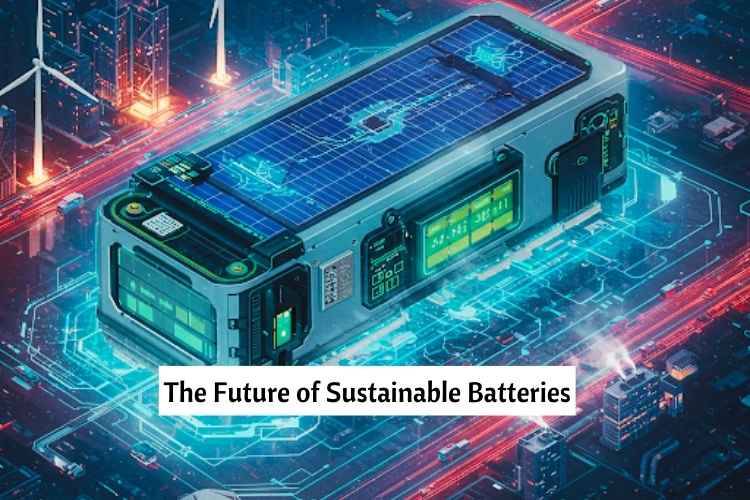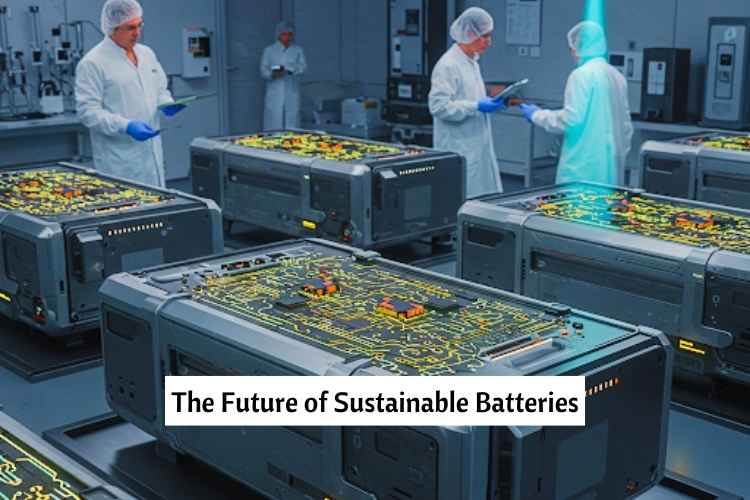The Future of Sustainable Batteries: As we step further into 2025, the global energy demand is skyrocketing — and with it, the need for cleaner, more sustainable power solutions. At the heart of this transition lies battery technology. From electric vehicles (EVS) to renewable energy storage, batteries are powering the future. But not just any batteries — sustainable batteries are taking centre stage. These next-generation energy sources promise lower environmental impact, longer lifespans, and greater efficiency.

Table of Contents
The Future of Sustainable Batteries: Growth in 2025

1. Solid-State Batteries: The EV Game-Changer
Solid-state batteries replace the flammable liquid electrolytes found in traditional lithium-ion batteries with a solid material, making them:
- Safer
- More energy-dense
- Longer-lasting
Toyota and QuantumScape are leading the charge, with expectations to commercialise these by 2027. Some prototypes now offer double the energy density of current EV batteries.
2. Green Lithium Extraction
Traditional lithium mining is water-intensive and harmful to ecosystems. But now:
- Direct Lithium Extraction (DLE) is emerging, using cleaner methods and fewer resources.
- Companies like Lilac Solutions in the U.S. and Vulcan Energy Resources in Europe are scaling DLE operations that cut water use by 90%.
3. Sodium-Ion and Other Alternatives
Lithium isn’t the only metal in the game. Sodium-ion batteries offer a cheaper, more abundant alternative, significant for regions without lithium reserves.
- CATL, the world’s largest battery maker, released its first sodium-ion battery in 2023 and is now improving cycle life and performance.
- These batteries are less energy-dense but ideal for stationary energy storage (e.g., solar grid backup).
4. Battery Recycling and Second-Life Uses
E-waste is a growing concern. In response, companies are pushing:
- Closed-loop battery recycling systems (e.g., Redwood Materials, Li-Cycle)
- Second-life EV batteries are being used for home and commercial energy storage.
The Global Push: Who’s Leading in 2025?
| Region | Key Players | Focus Areas | Notable Advances |
|---|---|---|---|
| USA | Tesla, Redwood Materials, QuantumScape | Localised battery supply chain initiative | Tesla’s 4680 cell ramp-up, Redwood’s closed-loop |
| China | CATL, BYD | Sodium-ion, mass manufacturing | CATL’s low-cost sodium-ion scaling |
| Europe | Northvolt, BASF, Volkswagen | Ethical sourcing, DLE, gigafactories | Northvolt’s fully recyclable battery |
| Japan & Korea | Panasonic, LG Energy Solution, Toyota | Solid-state R&D, hybrid tech | Toyota’s solid-state prototype 2024-2025 |
| India | Ola Electric, Exide Industries | Lithium-free alternatives, low-cost EV batteries | Localized battery supply chain initiative |
Conclusion
The future of sustainable batteries in 2025 is exciting, promising, and pivotal — but also complex. Breakthroughs in solid-state tech, green lithium, and sodium-ion batteries are revolutionising how we store and use energy. At the same time, supply chain, cost, and policy challenges continue to hold back rapid transformation.
To realise the full potential of this battery revolution:
- Investments must scale
- Governments must regulate smartly
- Consumers must be better informed
As we charge into a cleaner, more connected world, sustainable batteries will be both the foundation and the fuel. The choices we make in 2025 will shape how that energy future looks for generations to come.
Bhakti Rawat is a Founder & Writer of InsureMyCar360.com. This site Provides You with Information Related To the Best Auto Insurance Updates & comparisons. 🔗
